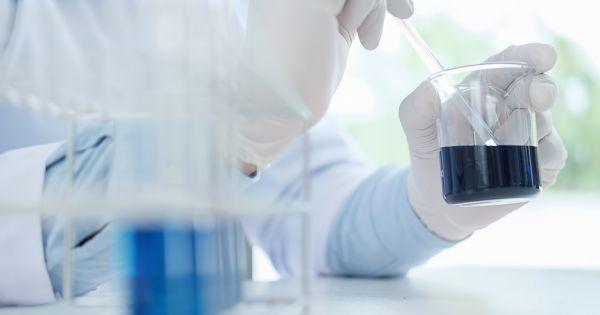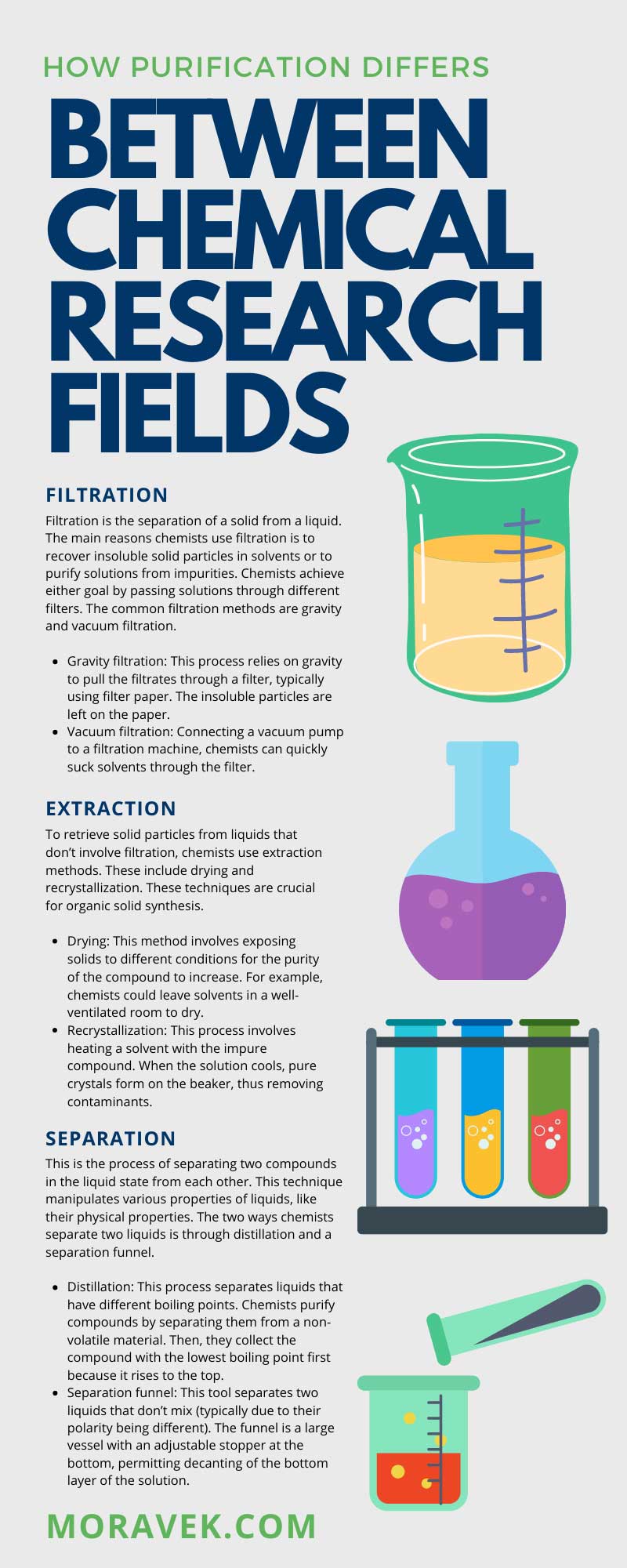
When separating chemical compounds, scientists use purification techniques to remove impurities. Given the different properties of compounds, there isn’t a singular method for purification. In fact, purification differs between chemical research fields. Keep reading for insightful information on purification and its variations.
What Is Purification?
Purification is the process of physically isolating, separating, or removing foreign or contaminating substances from a compound. Essentially, purification of a compound refers to increasing its quality by eliminating impurities.
Purification is necessary after chemical synthesis, which is a process in which chemists perform several multi-step chemical reactions. The objective of this process is to transform a starting material (or reactant) into one or more products. When materials become new products, chemists must purify them before clinical trials. This ensures product safety and helps manufacturers receive the right results.
The ability to effectively separate chemical mixture quantities into purer forms reaps advantages for people worldwide. From a pharmaceutical standpoint, getting rid of contaminants improves drug quality. After all, the goal is to create medicine that helps people, not hurts them. By isolating specific compounds, people receive pure medications.
Why Does It Matter?
Purification is important because it allows the organic compounds manufacturers use to have high purity for reactions. Without purification, drug manufacturers risk adverse effects with medications. For example, contaminants can cause harmful side effects to consumers. There’s also the chance of medications not working for their intended use.
Medicine development is a lengthy process. According to Biopharmaceutical Research & Development, the first stage of the process takes approximately three to six years. Development requires preliminary research, target validation, safety tests, preclinical trials, optimization, and other related tests—not to mention the approval time and certifications from the FDA. Ultimately, processes can take well over a decade to complete.
All this to say, chemists dedicate a lot of time and effort toward drug development. Failing to purify drugs diminishes years of work. It’s always best to put a safe and effective supplement on the market!
Understanding the Chemical Research Fields
As an umbrella word, chemistry refers to the scientific study of properties and the behavior of matter. It covers the elements that make up matter, like atoms, molecules, and ions. However, each area of chemistry focuses on specific things.
The five areas of chemistry include analytical chemistry, biochemistry, organic chemistry, inorganic chemistry, and physical chemistry. According to the American Chemical Society, here’s an overview of the areas:
- Analytical chemistry: the science of obtaining, processing, and communicating information about the composition and structure of matter
- Biochemistry: the study of the structure, composition, and chemical reactions of substances in living systems
- Organic chemistry: the study of the structure, properties, and reactions of compounds and materials that contain carbon atoms
- Inorganic chemistry: the study of properties and behavior of inorganic compounds, including metals, minerals, and organometallic compounds
- Physical chemistry: the study of how matter behaves on a molecular and atomic level and how chemical reactions occur
Purification and Research Fields
As we mentioned, each area of chemistry involves studying different things. Chemists have preferred results when they run experiments or test compounds, including purification. Therefore, purification differs between chemical research fields in the various methodologies for extracting substances. We’ll dive into the three distinct ways to purify compounds below.
Purification Methods
The main purification methods are filtration, extraction, and separation. Each method has subcategories for specific processes. Review purification methodology to learn how they differ.
Filtration
Filtration is the separation of a solid from a liquid. The main reasons chemists use filtration is to recover insoluble solid particles in solvents or to purify solutions from impurities. Chemists achieve either goal by passing solutions through different filters. The common filtration methods are gravity and vacuum filtration.
- Gravity filtration: This process relies on gravity to pull the filtrates through a filter, typically using filter paper. The insoluble particles are left on the paper.
- Vacuum filtration: Connecting a vacuum pump to a filtration machine, chemists can quickly suck solvents through the filter.
Extraction
To retrieve solid particles from liquids that don’t involve filtration, chemists use extraction methods. These include drying and recrystallization. These techniques are crucial for organic solid synthesis.
- Drying: This method involves exposing solids to different conditions for the purity of the compound to increase. For example, chemists could leave solvents in a well-ventilated room to dry.
- Recrystallization: This process involves heating a solvent with the impure compound. When the solution cools, pure crystals form on the beaker, thus removing contaminants.
Separation
This is the process of separating two compounds in the liquid state from each other. This technique manipulates various properties of liquids, like their physical properties. The two ways chemists separate two liquids is through distillation and a separation funnel.
- Distillation: This process separates liquids that have different boiling points. Chemists purify compounds by separating them from a non-volatile material. Then, they collect the compound with the lowest boiling point first because it rises to the top.
- Separation funnel: This tool separates two liquids that don’t mix (typically due to their polarity being different). The funnel is a large vessel with an adjustable stopper at the bottom, permitting decanting of the bottom layer of the solution.
Methodology Distinctions
Chemists use specific purification methods to achieve accurate results. The methodological distinctions for extracting substances depend on the type of substance chemists want to purify.
The most common difference that arises with purification methods depends on if the solution needs a physical or chemical property change. For instance, if chemists need to heat a substance or mix it with another solution, then distillation is necessary.
The other important distinction depends on the compound chemists want to extract. For example, chemists must be careful about the experimental setup when extracting a liquid as opposed to a solid.
Scientists closely examine their experiments to determine the right purification technique. After all, they don’t want to change necessary or important properties of compounds.
Do Chemists Have a Preferred Method?
As we’ve discussed, different methods achieve different results. Depending on the area of chemistry, chemists may have a preferred purification method. Keep in mind, though, that preferences and best practices are always subject to change. A chemist may discover one technique is no longer relevant to their project. In those situations, they’ll switch methodologies. Most professionals examine past work to determine the best purification techniques and their results.
Let Moravek handle quality control and analytical services. Our skilled chemists offer HPLC analysis services with Five Agilent 1200 HPLCs, Bruker UltraShield 400 Plus NMR with a broadband probe, and much more! We look forward to hearing from you.

